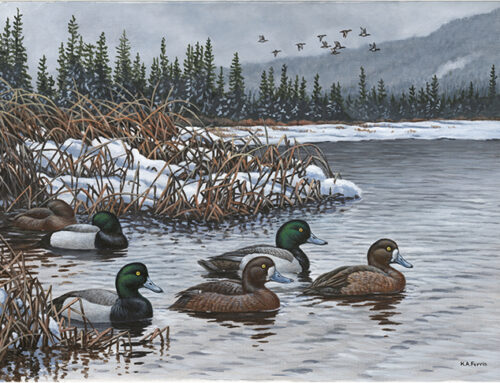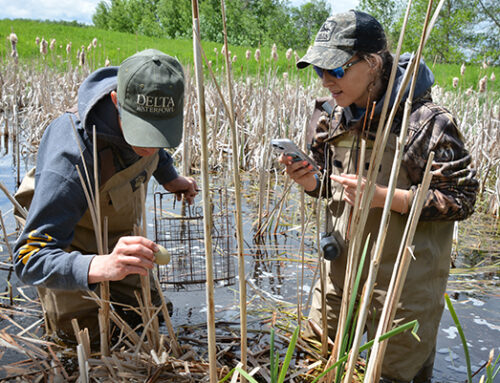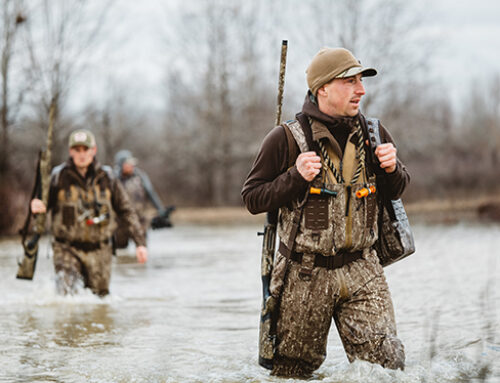Delta Waterfowl Working to Expand Successful Shallow Wetlands Incentive Program
Habitat conservation initiative aims to work with farmers to keep at-risk wetlands producing ducks in Canada

For immediate release
November 22, 2023
WINNIPEG, MANITOBA — The Canadian prairie continues to lose its allure to breeding ducks.
Delta Waterfowl is working to expand the organization’s habitat conservation programs that provide farmers with annual incentive payments to retain the region’s critical shallow wetlands where ducks can breed, nest, and thrive.
A significant chunk of Canada’s historic base of small wetlands in the prairie pothole region of southern Alberta, Saskatchewan, and Manitoba is already gone, and we’re losing more every year. Recent estimates put the annual small wetland loss rate at 0.37%, and the estimate jumps to 0.88% for wetlands imbedded in croplands. At the current pace, more than one-third of these vulnerable, remaining small wetlands will be lost in the next 50 years. And once that habitat disappears, it’s never coming back.
“Think about what the world will look like to mallards and pintails in prairie Canada if we lose another 35% of the small wetlands in cropland, not to mention all of the wetlands we’ve already lost,” said John Devney, chief policy officer for Delta Waterfowl.
To help slow down wetland habitat losses across prairie Canada, Delta Waterfowl is considering how to emulate Manitoba’s successful Shallow Wetlands Incentive Program for Alberta and Saskatchewan—provinces with millions of small wetlands—to ensure the breeding duck habitat in prairie Canada remains viable and continues to produce ducks. Shallow prairie wetlands serve as territorial pair ponds that drive carrying capacity for breeding ducks and provide important food resources for nesting hens. Studies show that 10 one-acre wetlands attract 21 breeding pairs of ducks, while one 10-acre wetland attracts only seven pairs.
Delta’s goal for SWIP is to conserve 90% of ephemeral, temporary, and seasonal wetlands in Alberta and Saskatchewan.
SWIP builds on Delta’s successful model of wetland conservation adopted by Manitoba in 2018 as part of the province’s GRowing Outcomes for Watersheds, a.k.a. the GROW Program. GROW was established as a $204 million trust that includes the provision of $2.5 million annually for wetland conservation. Local watershed districts administer 10-year contracts to conserve ephemeral and temporary wetlands. About 4,000 additional acres of critical breeding duck habitat are being enrolled each year. The overall goal of GROW is to conserve 90% of the province’s small, shallow wetlands.
“Through SWIP, we hope to achieve in Alberta and Saskatchewan what we’ve been able to accomplish in Manitoba with GROW,” said Jim Fisher, vice president of Canadian policy for Delta Waterfowl. “These shallow wetlands have been part of the Canadian prairie since the glaciers retreated, so when you think about losing 35% of them in the next 50 years, it’s shocking. That’s not a great legacy.”
Delta Waterfowl has been leading efforts since the 1990s to work with farmers to conserve small, shallow wetlands that are so important to breeding ducks. Delta continues to develop the organization’s suite of voluntary, incentive-based programs to keep those vulnerable wetlands from being drained.
“SWIP is another important tool for wetland habitat conservation in prairie Canada,” Fisher said. “We take immense pride in ensuring that ducks return each spring to abundant wetland habitat on the prairies.”
Delta Waterfowl is The Duck Hunters Organization, a leading conservation group working to produce ducks and secure the future of waterfowl hunting in North America. Visit deltawaterfowl.org.
For more information, contact John Devney at (701) 471-4235 or jdevney@deltawaterfowl.org.






Leave A Comment